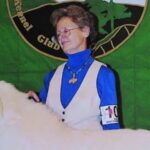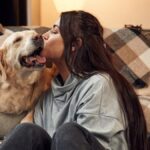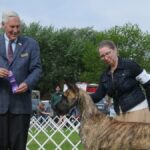Do Judges Make Mistakes?
Do judges make mistakes? I can just hear the answer to my question above and it is deafening, “Do they ever! Every weekend, every show, every breed, every class. And do you know who mentored him? That must be why!” In a sport where most participants do not win on any given day, there are always complaints from the losing and sometimes even those winning individuals.
But let’s be serious for a moment, judges are human and have their strengths and weaknesses, just like you and just like your dogs. You are disappointed to lose as you have taken 6 months to decide on your show prospect. Then it is discouraging if the judge does not validate your selection. But think about it, a judge has two to two and a half minutes to evaluate the good points of your animal and that time includes the paperwork, the handling tips and any other interruptions that occur.
Judges are asked to make decisions on the day, but it really is not merely on the day but in those 2 minutes and even in a few seconds in many instances. You claim your dog did come together in the last go round and you could feel this on the lead, but the judge was looking at his dog, not yours, in those precious seconds. He totally missed your exhibit’s moment of brilliance!
So let’s ask a more appropriate question, “Do Judges have regrets or second thoughts?” The answer has to be yes, of course. Again, judges are human.
Judges are Human
I posed the regret/misgiving question to several judges. I have quoted their responses which represent many situations in which they and their colleagues find themselves.
From one of our prominent judges: “Some exhibitors think that AKC Judges are perfect. Some AKC Judges think they are perfect. I am quick to say that “I am not perfect”. First, I am human. I try to do my best in everything I do, but being human I have made mistakes and/or decisions that later I would change (in my general life as well as judging dog shows). One can always rationalize why (2 minutes a dog plus they added all those additional events OR I have to go to the bathroom OR I didn’t sleep well in the hotel because the kids were playing in the hall, etc., etc.) but rational or not, all judges think back at one time or another and think, ‘I probably should have put this dog over that dog’.
Another reason is that sometimes I just “think too much”. What I mean by that is that it can be human nature to talk yourself into or out of awarding a dog because I put that specific canine under special consideration (positive or negative) that I did not do for the other canines. Later on… well sometimes it’s regret that my “gut” knew the better dog, but I let my emotions engage with my brain and the result was less than my best.
Of course most judges will admit they have had doubts numerous times and that they have agonized over it; others never make a mistake because they are always right on. We all know who they are; they have such confidence—or is it ego?
Yet Another Survey
I have taken another informal survey! (Groan together now, “Not another!”) This time it is a survey of judges about possible misgivings or second thoughts they may have experienced after or even during judging. For example a common one is, “My reserve really deserved the win today but at the last minute I chose the other one for his really correct tail set.” You say, “What happened to the whole dog?” On impulse, a sudden shift in thinking, he chose that dog? Is it a mistake or reason for regret? Or is it a judge’s prerogative to justify his decision based on a section of the standard—particularly if the trait they ultimately decide on is a common present day fault a breed is trying to eliminate. You be the judge.
Mentor Influence?
Are mentors and seminar presenters confusing judges by their emphasis on a detail or two, to the exclusion of the overall? A first experience with a breed is an introduction—overall make and shape to which the details contribute. To spend half a seminar on one detail may be counterproductive.
Let’s take an example of what sometimes occurs: the permit judge who has just completed a couple of those ringside mentoring things—ringside observations—is suddenly standing in the ring, the latest thing he learned flashes through his head. Things like the shape of the eye was most serious in one breeder/judge/mentor’s opinion, but his previous mentor told him that the tails were the most important feature and the eye shape really does not matter.
Low and behold, ‘Do I go back and re-check eyes and tails; I do not remember the eyes or tails of each dog? What do I do? I am confused.’ Some experienced breeders and judges feel that it happens too frequently that the impression of the whole dog is neglected, while instead merely the faults are emphasized at ringside. What happened to the judge finding what measures up to the standard and the qualities, first?
Serious Faults
Since serious faults are generally stated in a standard; beyond those and the DQs, it is the opinion of the breeder/or judge which fault is more to be penalized or serious than another. And this educated opinion, finding virtue, coupled with the fault’s degree of departure from the ideal is key to making a good decision.
Here is an example that I recently observed at a large Basset entry. In my opinion, the dogs in the classes were either way too much or too little substance. The winner I am told has flanged ribs. This is hearsay, but let’s use it as an example. We do have flanged ribs in the Basset and they show up frequently today. At the end of the round rib cage the cartilage of the rib flips upward not unlike the hairdo popular years ago. But judges, especially non-Breeder Judges rarely go over the rib cage carefully enough to find any flange.
In addition, at this show the two extremes of substance in the breed, how much is too much; how little too little? The judge was struggling with the entry so diverse. I would have been too. I was happy I was not judging this day. The standard does say smooth ribcage extending well back; it also says heavier bone, size considered than other breeds and also that the serious faults in the breed are those that impede movement. These statements from the standard must be interpreted: how far back? How smooth? If flanged ribs are present, is this fault more serious than inefficient running gear?
Current Problems in Breeds
This discussion leads to the current problems in breeds. Breeders know—or should know—these, but judges cannot always know them and what if emphasizing those should conflict with the standard that has not been changed in years? Until that issue is resolved in a standard change, a judge must go with what IS in the standard. Judges do not have time to always know the faults of the moment with every breed they judge. It is the standard they depend upon. But one might wonder, ‘Did I neglect what that breeder told me was most important because it is so prevalent a problem in the breed today?’
Some Honest Admissions
Here are some admissions of judges who were kind enough to let me use their experiences as examples. Judges often discuss these issues amongst themselves and the dialogue is healthy. I have removed their names to protect the innocent, honest and sincere.
From one judge in her early career:
“The most memorable ‘do over’ that I wish I had, was when I was provisional in Afghans. My assignment was in the Midwest and had a rather good entry. The dog classes were just average, but when the bitches came in, a puppy bitch really caught my attention. I ended up awarding her WB and BOW. I really wanted to give her BOB but was too afraid to do it over the special. I had the AKC Rep watching me and I was scared to death to make such a bold move with the Rep watching… so I chose the expected and went with the special that was big and coarse.
During my evaluation I learned the rep knew Afghans well or had bred them. Fortunately he was very nice and easy to talk to so I told him what I really wanted to do. He came back and completely agreed and said that is what he would have done! I felt verified, yet mad at myself for not going with my gut. Not being a breeder of this breed and knowing how some of the exhibitors can behave, I did the expected, in order not to make any waves. It was just lack of confidence but a good lesson.”
And another:
“In thinking back, I did a large Dachshund Specialty in Texas… where there used to be a lot of really good ones, and I did not choose a highly advertised Smooth, that was also highly ranked, for my BOB. I caught hell for that, but not knowing who was who ahead of time, allowed me to actually judge the dogs without influence of the stats. I suppose looking back at that early assignment, I might have wanted a do over to really see if the Smooth (that in some opinions) should have won. Who knows? It’s old news now.)
From another:
“During a recent Judging assignment of Afghan Hounds, I later reflected that I truly should have reversed what ultimately were my Winners dog and my Reserve Winners dog. Both were good examples of the breed, but in reflection, one was truly better than the other.
The handler on the Reserve dog insisted on constantly stacking the dog with its rear way too far back resulting in a very sloping top line (Standard:” The back line appearing practically level from the shoulders to the loin”), an exaggerated sweeping rear (Standard: “impression of a somewhat exaggerated bend in the stifle due to profuse trousering”) and this required the hound to straighten its front (Standard: “Shoulders have plenty of angulation”) just to be able to stand. When the dog moved, it was the superior dog. When the dog free stacked, it was the superior dog. When the handler interfered, it was the inferior dog. In retrospect, it was the better example of the breed, just poorly handled. Instead, I rewarded the other dog and with reflection, I can’t say that the best dog won on the day.”
Another:
“It was a large Open Dog class of Ridgebacks with several quality dogs. One dog really caught my eye when he first came into the ring, but then fell apart as he was obviously untrained. He pulled back on the exam, jumped around so I never could see him go down and back or around. So I regretted having to place him second to another I also liked very much. His regular handler brought him into the ring for reserve, and I wished I could chase down the WD and get the ribbon back to award this excellent exhibit now that he was going through his paces properly. Sometimes it’s not just ‘on the day’, it’s also ‘in the moment’.”
And Another:
“On occasion, I have found myself in the position of having judged a breed during the day—then doing the group later in the day. I would be satisfied with my selection for Best of Breed when it was awarded earlier in the day. However, there have been several occasions when the dog showed up in the group ring—and my thought was ‘WHAT was I thinking when I gave that dog Best of Breed?’ This change in my opinion of the quality of the dog could in theory be due to a variety of reasons—the dog is now tired and not ‘putting out’; different type of ring—inside vs. outside or grass vs. concrete; different handler that the dog may or may not work for—or it might have been the ‘best of the worse’ in some cases earlier in the day.”
Another:
“There were 4 Ibizans in the class. They went around the ring every which way, but I said to myself, ‘They will get better after being examined.’ Well they did not. They did not stand for the examination nor did they go down and back or around—not a one. That day, at that moment, I felt I could not place one over the other. I called them all into center ring and told them I was withholding all ribbons that day, that I did not know if it was genetics or environment or simply lack of training; but none of them belonged at a dog show that day. I thought I was being kind taking them all into the center of the ring and doing this quietly, but was I right? Bothers me ten years later that, maybe my job was to place them somehow.”
Another Example:
“Second guessing your decisions?? I think all of us who judge dogs have at times reflected on our decisions. We think about this the night after, the day after, when we see that dog the next day, or the next time we judge. What if we had it all to do over again? Was the one dog really as deserving as we first thought? One experience that I remember was a Bloodhound Specialty overseas. It presented me with the classic dilemma of beauty over function. The open bitch one was young, quite elegant with a very correct head structure, lovely eye and expression, scissors bite and a good length of body.
“Along with her beauty and elegance came a more narrow body structure and lighter bone. Her feet tended toward long rather than round and her toes were long and slightly splayed. Her down and back was true and her go around very smooth and elegant, but her stride shortened on the uphill side of the ring. Oh, and she was the big breed winner at the shows and number one in her breed. This breed has a working class in which the entries must have a working certificate in order to compete. The bitch in this class was lower stationed, somewhat common in the head and her expression was a little hard and her eye, although dark, tended toward round.
She was older and her teeth worn and her ears and body bore some honorable scars. Her coat was hard and her color deep and dark as preferred in the standard. Her feet were round and well knuckled, with thick pads. Her ribs were well sprung and her chest deep and full. Her down and back had her moving a little wide behind and a slightly out at the elbows on the return. Going around she looked powerful and on the uphill side of the ring she pushed powerfully off her rear and maintained her stride. The standard for this breed describes a breed built for hunting game, they should be strong and powerful, noble and dignified and while the head should be correct, there is no reference to beauty or elegance anywhere in
the standard.
“I put up the working bitch and gave the younger (and bigger winning one, the reserve CC). I did feel some anguish over my decision. As a breeder, I would love to have that head and expression of my reserve, but not at the expense of function. On the following day, the judge put up the younger bitch, my reserve CC, in a heartbeat and that made me ponder my decision again.
“I thought I might never be invited to judge there again; however, I was invited back two years later. At one of the show dinners, I was approached by one of the club members and he expressed his admiration for me because I did put up the older, less glamorous bitch, over the more elegant, but less functional one two years before. He said that not many judges, especially ones who are not breeders would ever have made that decision and that it was one of the reasons I was invited back.”
Finally:
Summarizing what each of us is saying, from another well-respected judge and his solution to his quandaries:
“Of course, we all have made mistakes when pointing to our winner. I prefer to call those ‘do overs’ (things I would love to do over). Actually after a weekend is done, it is not unusual for me to mentally revisit any decisions that I might have done differently. I try to make this a learning curve rather than beating myself over the head as I certainly cannot change anything.”
So you see judges do reflect and take their judging seriously; they really care. Might it be time to consider judges as human with virtue and fault like you and like your dog and attempt to see wheres the judge is coming from?
Originally appeared in Showsight, October 2015 Issue. SUBSCRIBE HERE.








